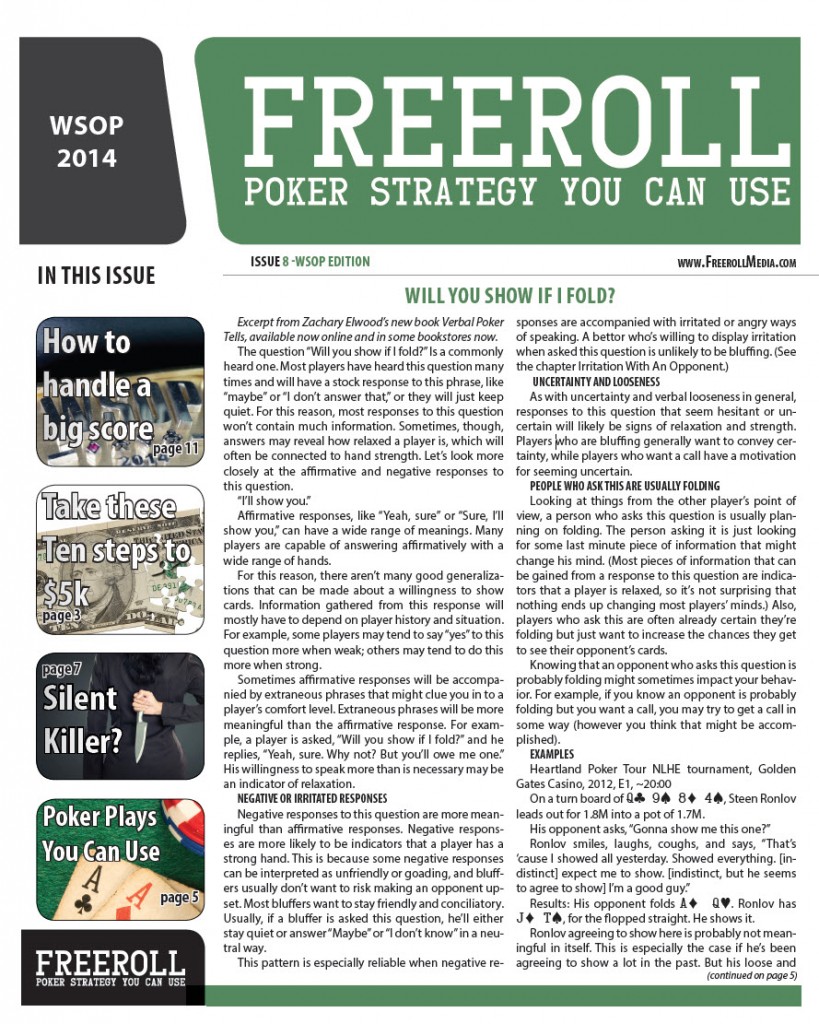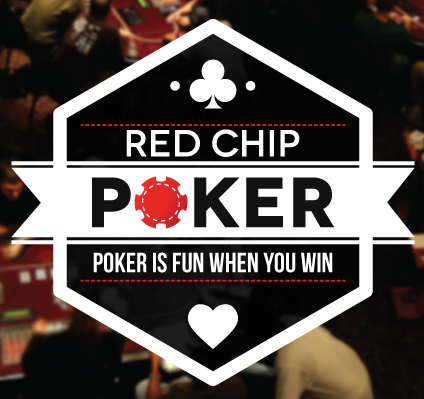Poker Is A Skill: How To Stop Losing, Part 2
- By Paul Hoppe
- January 20, 2014
- Comments Off on Poker Is A Skill: How To Stop Losing, Part 2
 Understand Relative Hand Strength
Understand Relative Hand Strength
Whenever someone new would show up at my old home game and want to learn poker, the first thing they needed to know was the ranking of hands. They’d get a card that looked something like this:
- Royal Flush A♥ K♥ Q♥ J♥ T♥
- Straight Flush J♠ T♠ 9♠ 8♠ 7♠
- Four of a Kind K♥ K♠ K♦ K♣ 4♣
- Full House 8♦ 8♠ 8♣ Q♦ Q♥
- Flush A♦ J♦ 9♦ 8♦ 2♦
- Straight 9♠ 8♦ 7♠ 6♣ 5♥
- Three of a Kind6♠ 6♥ 6♦ 4♦ 2♣
- Two Pair A♠ A♣ 8♠ 8♣ 2♥
- One Pair J♠ J♣ K♦ 7♥ 2♠
- High Card A♠ K♥ 8♦ 4♦ 3♥
While the card doesn’t specify whether aces and eights beat kings and queens or whether heart flushes are worth more than club flushes (of course they’re not), it does give the beginner a very simple frame of reference. It allows the fledgling player to see how high up the food chain their hand ranks. But it also fails to highlight one of the most essential qualities of poker, even while alluding to it.
If you’re one of those players still learning the ranking of hands, then the above chart might be the most useful part of this article. But if you’ve played a bunch of hands without getting the results you want, then understanding the following is probably the most important thing you can do at the table.

Poker is a game of relative strength.
If you and I play five card draw, where just the two of us get five cards each with one opportunity to replace whichever cards we discard, I can be fairly confident if I make any hand that utilizes five cards. That is to say, if I am dealt a straight or better, then I have a good chance of winning the pot, particularly if I see that you need to draw multiple cards to improve your hand.
However, if you go on to raise me after the draw, fully knowing that I have drawn no cards, should I be confident with a Six-high straight? No, I shouldn’t. In fact, my hand has gone from powerhouse to bluff catcher. The absolute strength of my hand has not changed, but the relative strength has greatly diminished.
How to judge relative strength.
There are three major components to the relative strength of a hand.
The first one is the absolute strength. A royal flush will always be the nuts. Unless you are playing some wacky home game with wild cards and someone makes five of a kind, a royal flush will always win the pot. If, on the other hand, you hold seven-high (7,5,4,3,2 of multiple suits), then your hand will never win a showdown unless you happen to be playing deuce-to-seven lowball (in which case that old royal flush will be the worst possible hand). But ignoring lowball for the remainder of this article, where your hand ranks on the overall continuum of poker hands will be the starting point for determining its relative strength.
The second component exists in games like hold’em, where the community cards impose some restrictions on the hands which are possible. You may only hold a Six-high straight, but if the board is 3♠2♥6♦K♣Q♣, then your 4♠5♠ is the nuts. That is to say, there is no way your opponent can beat you. When you hold the nuts, it doesn’t matter whether it’s four-of-a-kind or just three Queens (e.g. Q♦Q♥on Q♠J♦7♠3♣2♣). You may as well be holding a royal flush. The relative strength of your hand in this case would give you absolute power to win the pot.
When you’re playing a game with a board like hold’em, instead of thinking of where your hand fits within the overall rank of poker hands, you should instead value it based on how close it is to the nuts. If you take that board of 3♠2♥6♦K♣Q♣ where a Six-high straight was the nuts, you can see that a set of Kings would be the second nuts, a set of Queens would be the third nuts, and so on. Top two pair, Kings and Queens, would be the seventh-best possible hand on this board; Ace-King, for top-pair/top-kicker, would be the seventeenth-best possible hand, and on and on.
When you have King-Jack on this board, you don’t need to be thinking that you have the eighteenth-best possible hand. But you do need to have a general idea of where your hand lies on the spectrum of hand strength.
The third and final major component of relative hand strength is the betting action taken by you and your opponents. Whether, when, and how much your opponents bet should give you some indication as to the strength of their hands. (Part 3 of Stop Losing will delve deeper into the concept of reading hands and putting your opponents on a range, but for now just think about what your opponents’ actions mean.)
Also consider the actions you’ve taken to this point in the hand. Have you shown a lot of strength? If you have been betting and raising the whole way, then when your opponent plays back at you, he is representing a very strong hand. Sure, he may be bluffing some of the time, but he is unlikely to hold a hand of moderate strength. When the action gets heavy, moderately-strong hands become weak hands. Strong hands become only moderately strong, and it takes a very strong hand indeed to remain strong in a relative sense.
Remember: the strength of your hand only matters in relation to the strength of your opponent’s hand. Either you have the best hand or he does. (Sometimes you have the same hand and you split the pot.) It doesn’t matter how much you win by. It only matters that you win. In fact, the largest pots are often won by the thinnest of margins. If you have a great hand, would you rather your opponent hold a mediocre hand or a great-but-slightly-less-great-than-your-hand hand? The second one is the way you get paid the maximum.
It’s also important to remember that the relative strength of your hand changes as the flop, turn, and river come out. When you hold Aces before the flop, you have the nuts. You want to get as much money in there as you can. But if your aces are black and the board comes out 9♥8♥7♥, then your hand has lost a lot of its value. If, however, the turn and river are both nines, then you should be happy about your hand again. You beat everything except for straight flushes and quads.
Let’s wrap it up with one example which shows how all of this works together.
You are dealt 4♣3♣ on the button and everyone in front of you folds. You make a small raise and only the Big Blind calls.
The flop comes out 2♣5♥6♣. Hooray! You’ve flopped the nuts. Not only is your hand the absolute best possible hand right now, you’ve also got a flush draw, so if your opponent also flopped a straight, you’re on a freeroll. Your opponent checks, you bet, and he calls.
The turn is the 7♥. You flopped a Six-high straight and now you’ve got a Seven-high straight. But has your hand improved? Absolutely not. While the absolute ranking of your hand has improved, the relative strength has decreased. You can lose to an Eight-high straight or a Nine-high straight, neither of which was possible on the flop. You still bet when your opponent checks and you’re happy with his call, but you’re not quite as happy as you were on the flop, and you’re worried about a lot of the possible river cards.
Speaking of river cards, the K♣ comes off on the end. You’ve made a flush! But has this actually improved your hand? No. You were confident you held the best hand when your opponent just called the turn, and now you have the nut-low flush. Your opponent needs a flush to beat you, but any flush your opponent can hold will beat you. He checks. You evaluate the relative strength of your hand.
Your opponent could have just made a flush. But he could also have any number of worse hands, all of which you beat. You know that this opponent would often check/raise his flush draws on the flop, so you put in a sensible value bet, hoping for a call from a pair or two-pair type of hand.
Your opponent now raises all in. Everything has changed. Your hand went from the nuts on the flop to a slightly less nutty hand on the turn and river. But you were still looking good when your opponent was being passive. But now he’s committed his whole stack, representing a bigger flush. Does he have it? I don’t know. Maybe he’s holding A♣7♣ and is begging for a call. Maybe he has A♥2♥ and he’s praying for a fold. It’s up to you to decide how likely your opponent is to have the hand he says he has. We’ll look at that and the question of pot odds in parts 3 and 4. For now we’ll focus on the takeaway.
While the absolute strength of your hand can change from street to street, it’s more important to focus on the relative strength of your hand. You do this by reading the board to see what hands are possible and where your hand fits in on that spectrum, then considering the betting action taken by you and your opponent(s). Do your best to stay one step ahead of your opponents, both in relative strength and thinking.


